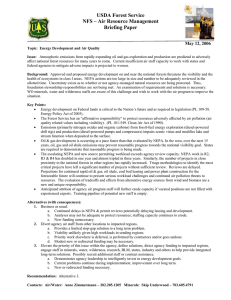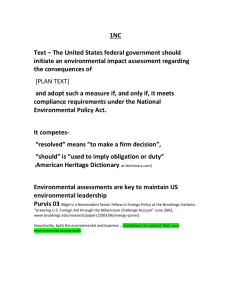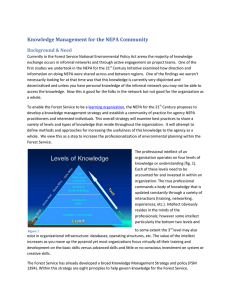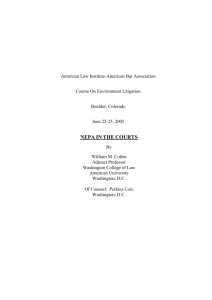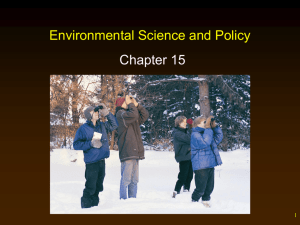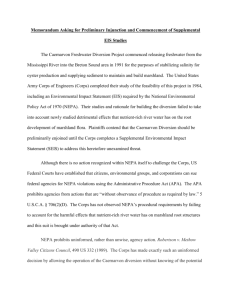Counting on Catastrophe Oil Spill and Environmental Disasters
advertisement
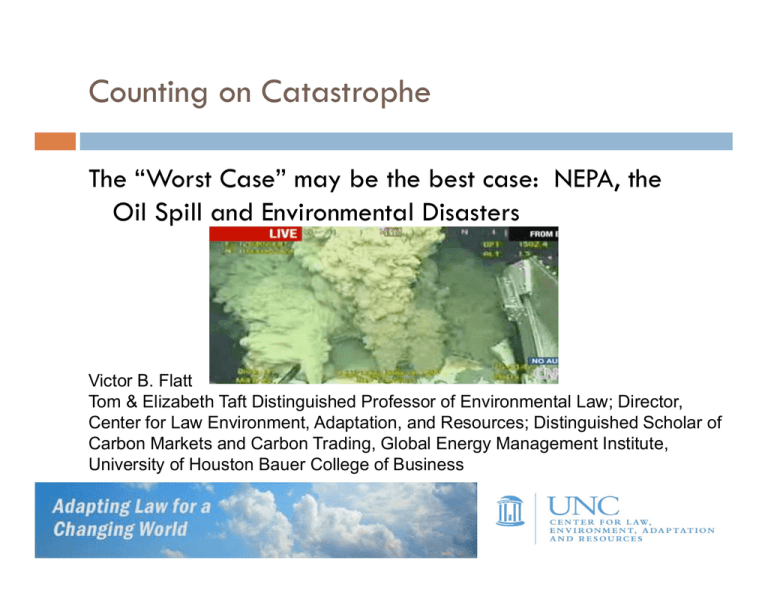
Counting on Catastrophe The “Worst Case” may be the best case: NEPA, the Oil Spill and Environmental Disasters Victor B. Flatt Tom & Elizabeth Taft Distinguished Professor of Environmental Law; Director, Center for Law Environment, Adaptation, and Resources; Distinguished Scholar of Carbon Markets and Carbon Trading, Global Energy Management Institute, University of Houston Bauer College of Business Overview The Oil Spill Exposed Regulatory Failures With Anticipating Environmental Disasters Focus on NEPA The Sequence of NEPA procedure for the Macondo Well Problems with the use of Categorical Exclusion (CE) Can recognition of Worst Case provide EA/EIS analysis to prevent this kind of disaster in future? (worst case?) Regulatory Failures In Environmental Protection “…most notably in the Gulf, some environmental protections and safety oversight were formally relaxed or informally diminished so as to render them ineffective…” (National Commission on the BP Deepwater Horizon Oil Spill and Offshore Drilling 56) Report Regarding the MMS’s NEPA Policies, Practices and Procedures as the Relate to the Outer Continental Shelf Oil and Gas Exploration and Development – August 16, 2010 Why Regulatory Failure Generally - Major Policy Conflict Between Environmental Protection and Energy Independence (inherent in OCSLA) Specifically -Problem with MMS application of OCSLA and NEPA Issue Present in Other Resource Laws NEPA designed for this kind of consideration Why Hasn’t Worked? NEPA Timeline EA on deepwater operations in the Gulf – 2000 OCSLA Lease Sale 2007-2012 Programmatic EIS – 2007 Gulf of Mexico OCS Oil and Gas Lease Sales: 2007-2012 Western Planning Area Sales 204, 207, 210, 215 and 218 Central Planning Area Sales 205, 206, 208, 213, 216, and 222 Programmatic EIS-2007 NEPA Timeline continued… BP Initial Exploration Plan – Categorical Exclusion 2009 BP’s Revised Exploration Plans for Amendment for the Macondo Well – CE - 2009 BP’s Application for Permit to Drill – CE 15.4C(12)– May 2009, Jan. 25, 2010, March 15, 2010, April 15, 2010. ROD indicates approval in March and April on same day of application. Categorical Exclusion Problem with Tiering CE because taken care of Under OCSLA Spill response plan – worst case analysis 162,000 barrels per day Recommendation to “Revisit” CE – CEQ; Less use of CE – Oil Spill Commission Without CE EA/EIS for each individual exploration plan? Application to drill? NEPA process should consider spill and spill response Does OCSLA timing limit NEPA? Worst Case? – Statutory Proposal in OCSLA; Arguably NEPA already requires NEPA Worst Case Analysis Robertson v. Methow Valley, 490 U.S. 332 (1989) affirmed that NEPA did “require all agencies to describe environmental impacts in the face of substantial uncertainty.”[1] [1] Robertson, at 354. information that can be discussed in NEPA documents “includes impacts which have catastrophic consequences, even if their probability of occurrence is low, provided that the analysis of the impacts is supported by credible scientific evidence, is not based on pure conjecture, and is within the rule of reason.” - Dinah Bear If EIS would consider Environmental Impact, should be considered in determining whether an EIS NEPA Worst Case Analysis – cont. If EIS would consider Environmental Impact, should be considered in determining whether an EIS “No provision of NEPA, or any other authority cited by the Commission, allows the NRC to eliminate a possible environmental consequence from analysis by labeling the risk as ‘unquantifiable’”. San Luis Obispo Mothers for Peace, 449 F.3d. 1016 (9th Cir. 2006). Conclusion Whatever Happened Statutorily, NEPA can be marshalled without statutory changes. Public Has To Be Vigilant – Applying NEPA Challenges Where Necessary
